When I am New York City I always go to the Metropolitan Museum of Art or the MET, for short. It is one of my favorite places. The art is amazing and I learn so much. As I mentioned in my last Art Talk post Art Talk: MET Highlight tour
When I go to museums I do a tour. Looking at art is ok, especially if you are familiar with the artist or piece. Going on a tour is where the real enjoyment of museums comes in and the pieces come to life as you get to learn about them!
In November I went two days in a row. The first day I did the Highlight tour and the second day, I did the Art of Japan tour. This tour was in Gallery 224, 225, 226, 227, 231 which are galleries that that are dimly lit. The painting, sculpture, and decorative arts change twice annually, while especially light-sensitive works such as prints and textiles rotate four times per year. 1

Section of the Landscapes of the Four Seasons, Soami, Died 1525
Screens
This section of the Japanese gallery has a lot of folded screens or byobu, which was a neat way to see the art displayed. It also gives the artist a lot of space to paint a variety of subjects on one screen and have them all go together.
This piece is showing all four season. You can view it as a whole of get close up and see the individual seasons as depicted by the artist.
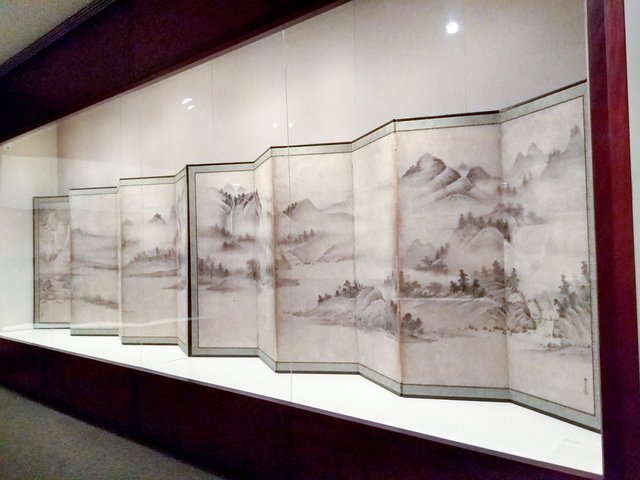
相阿弥筆 四季山水図 (瀟湘八景) Landscape of the Four Seasons (Eight Views of the Xiao and Xiang Rivers)
Sōami Japanese
Muromachi period (1392–1573)
early 16th century
Pair of six-panel folding screens; ink on paper
Interesting note: Gift of John D. Rockefeller Jr., 1941
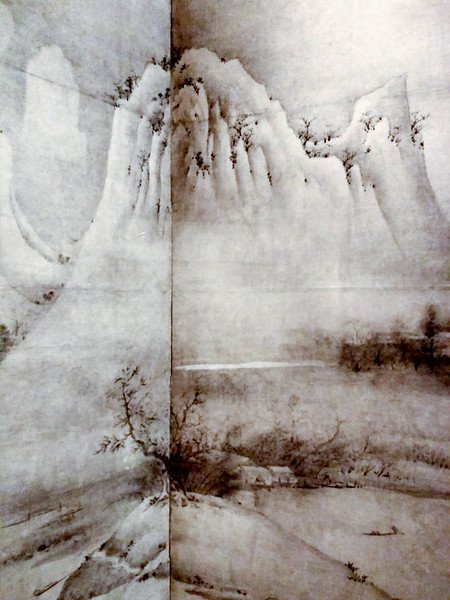 | 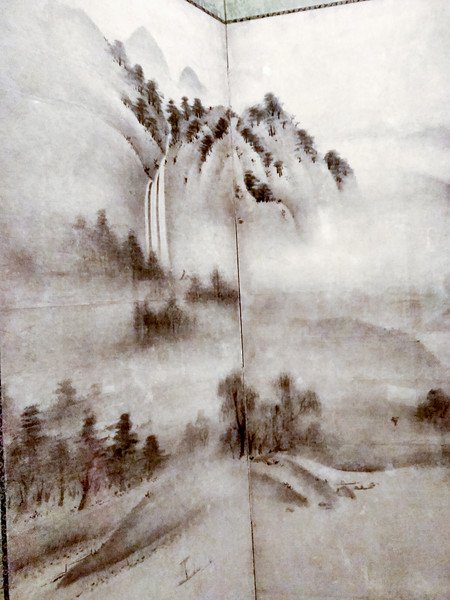 |
|---|

During the tour the guide also talked a little about how the screens would be set up in the homes of samurai lords as symbols of their wealth and power.
With this next piece we see the addition of gold leaf on the screens. The light from the candle would hit the gold leaf and lighten up the room even more.
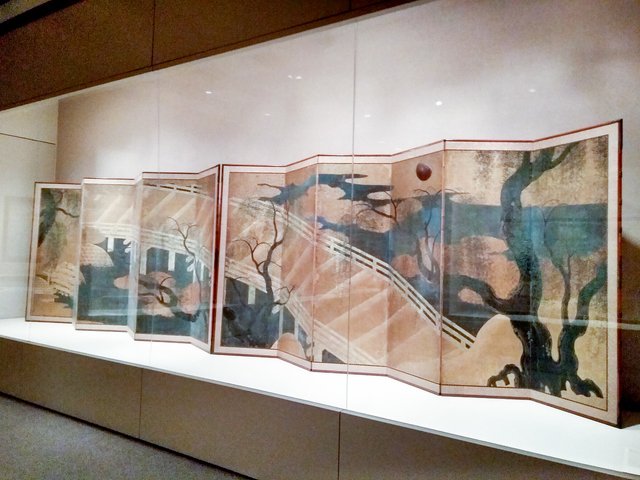
柳橋水車図屏風 Willows and Bridge
Momoyama period (1573–1615)
early 17th century
Pair of six-panel folding screens; ink, color, copper, gold, and gold leaf on paper
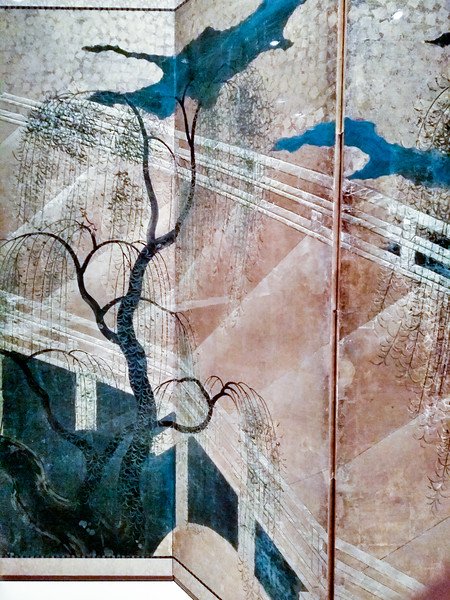 | 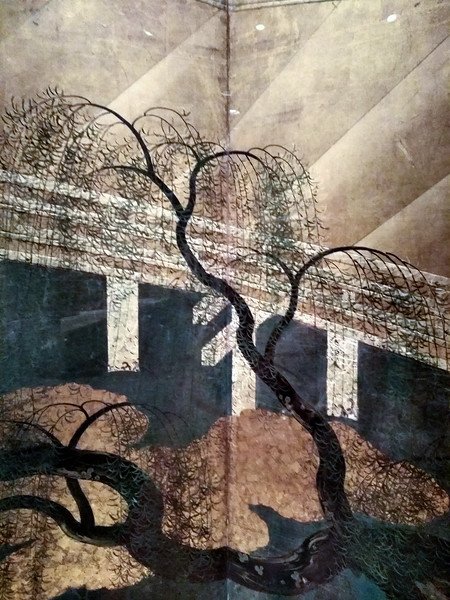 | 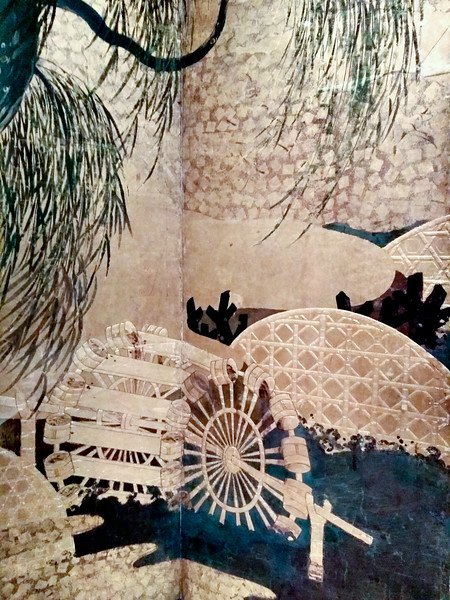 |
|---|
According to the MET
Paintings that combine willows with a bridge and waterwheel immediately evoke the bridge over the Uji River in southeast Kyoto, a view long celebrated in literary works such as The Tale of Genji. Paintings of the Uji Bridge decorated palaces by the 900s and remained popular for the next thousand years. 2

This next pair of screens or byobu is of the 17th century Koyto or what is now Tokyo.
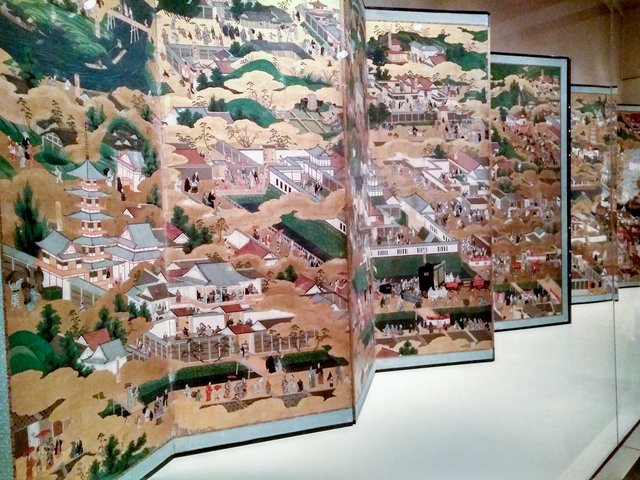
洛中洛外図屏風 Scenes in and around the Capital
Edo period (1615–1868)
17th century
Pair of six-panel folding screens; ink, color, gold, and gold leaf on paper
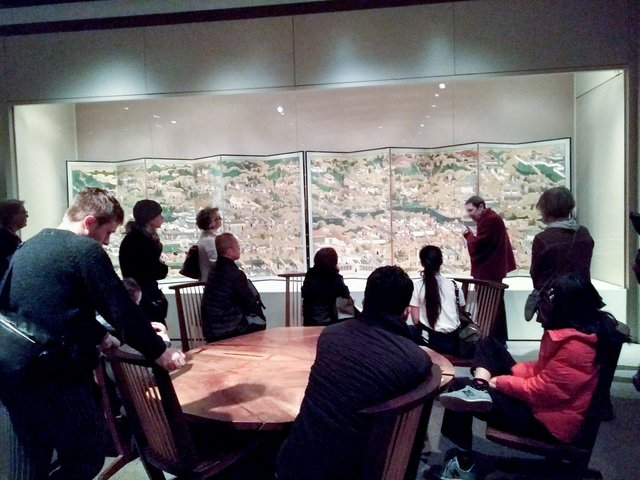
To give you a little perspective this is the group listening to the guide in front of the piece.
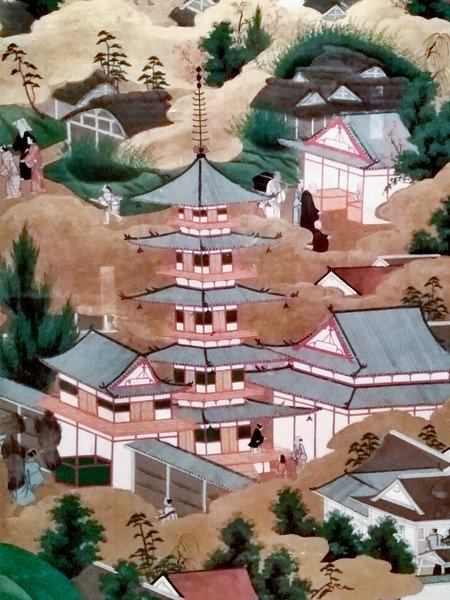 | 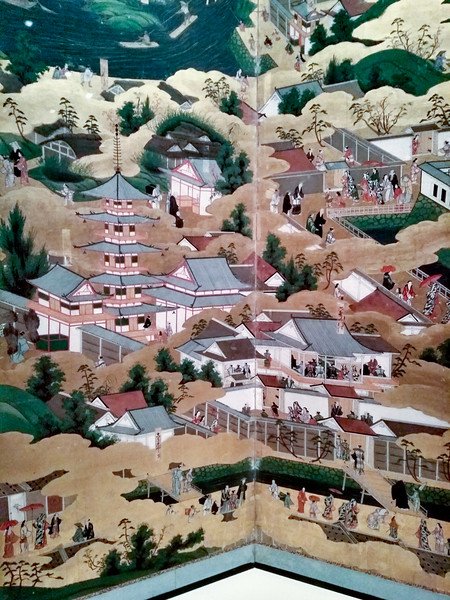 | 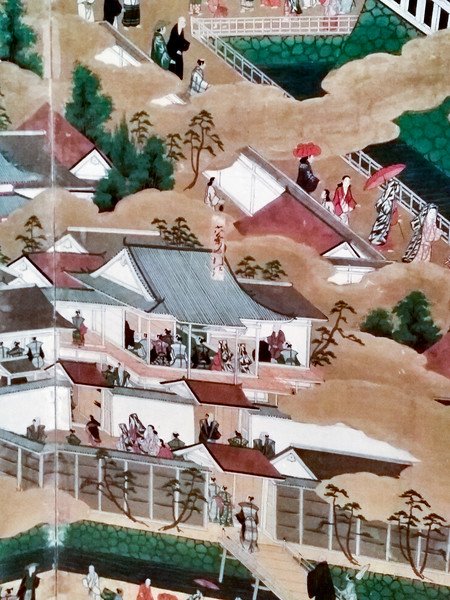 |
|---|
You can see that the gold leaf that was started in early 17th century has continued. This is a very large piece and has so much detail. It would be interesting to go back and really look at all the people and what they are doing.

Fabric
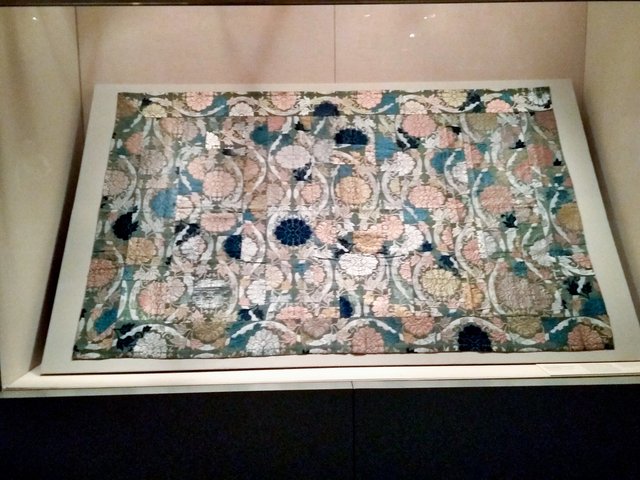
七条袈裟 牡丹模様 Seven-Panel Buddhist Monk’s Vestment (Shichijō kesa) with Peony Patterns in Undulating Columns
Edo period (1615–1868)
ca. early 18th century
Twill-weave silk with supplementary weft patterning
Interesting note: Purchase, Joseph Pulitzer Bequest, 1919
It is fascinating that this kesa is made for the scrapes of other garments. The picture on the left is Portrait of Keinan Eibun, 1449 and you can see how the garment was worn over the shoulder.
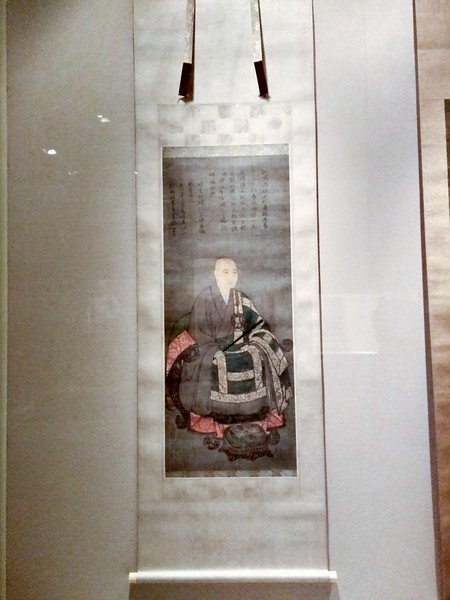 | 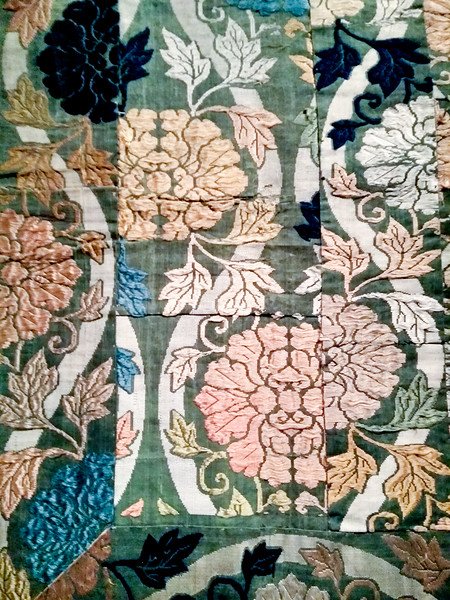 |
|---|


Robe (kosode) with pine, ivy, chrysanthemums, and river
mid-19th century
According to the MET
This robe belonged to Yuki-gimi. It is a formal garment with her family crest on the back and around the neckline on the front. Its chartreuse ground is animated around the hem with auspicious symbols of longevity and youth—pines, ivy leaves, and chrysanthemums. 3
The guide said that this garment was so starched and stiff that Yuki-gimi climbed out of it during a party and left it standing without her.

Lacquer Box
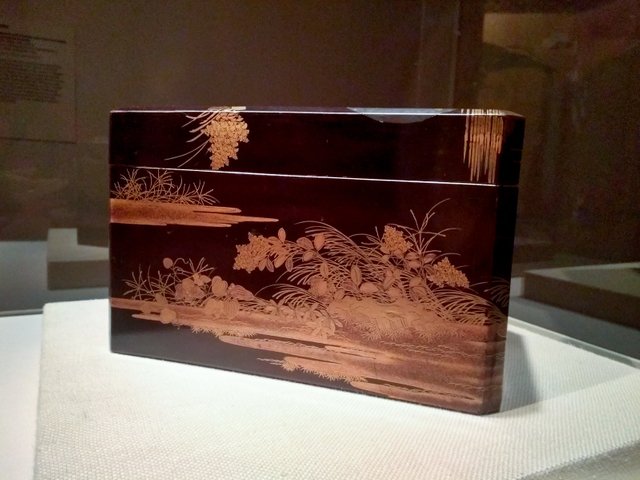
江戸時代 月秋草蒔絵旅櫛箱 Stationery Box with Moon and Autumn Grasses
Edo period (1615–1868)
18th century
Black lacquer with powdered and sprinkled gold and silver hiramaki-e and silver foil application
Our guide talked about how painstakingly the artist sprinkled tiny bits of gold foil on to the box to create the designs you can see in this picture.
The scene is of the full moon at harvest time. It was fun to learn that there was a custom to hold moon viewing parties.

Tea Utensils

Tea at Buddhist Temple and Tea-Utensil Stand Display
This is a less formal tea display.
According to the placard
The utensils on the bottom shelf include a portable brazier (furo) and kettle (kama) at left, a ladle stand (shakutate) at center back, a freshwater jar (mizusashi) at right; and a used-water container (kensui) in front of the daisu at left. On the top shelf are a tea bowl (chawan) and lacquer tea caddy (natsume) for green tea powder.
To the very far right is a Clog shapped tea bowl which I want to highlight.
黒織部沓形茶碗 Clog-Shaped Tea Bowl (Chawan) with Plum Blossoms and Geometric Patterns
Momoyama period (1573–1615)
early 17th century
Stoneware with iron-black glaze (Mino ware, black Oribe type)
I am highlighting this because it is such a great example of wabi-sabi which is "where both life and art are beautiful not because they are perfect and eternal, but because they are imperfect and fleeting." Essay by David Watts Barton, What Does Wabi-Sabi Mean? 4
MET description on the tea bowl
Tea bowls in the Oribe style were often shaped something like ancient clogs and described as kutsugata, or "clog-shaped." After a round tea bowl had been formed on the wheel, it was indented in several places, destroying the circular shape and producing an asymmetrical form. The exterior surface of the bowl was then worked with a spatula to make it rough and uneven. Flamboyant distortions and irregularities of this type characterize the aesthetics of Oribe ware. 5
There is so much to say about the thousands of year ritual of the Japanese tea ceremony. The most interesting thing I learned on this tour is that each tea gathering is a unique experience, so a particular assemblage of objects and people is never repeated. For more information on the Tea Ceremony see the MET essay The Japanese Tea Ceremony

Bonus pieces
Our tour guide had some specific art she wanted to highlight in the galleries in a certain time frame. She couldn't pass up the opportunity to tell us about two more pieces that were ancient and modern on our way to the tour.
On special display, right outside the gallery, is the oldest piece in the MET at 3500 BC making it about 5000 years old. Amazing!
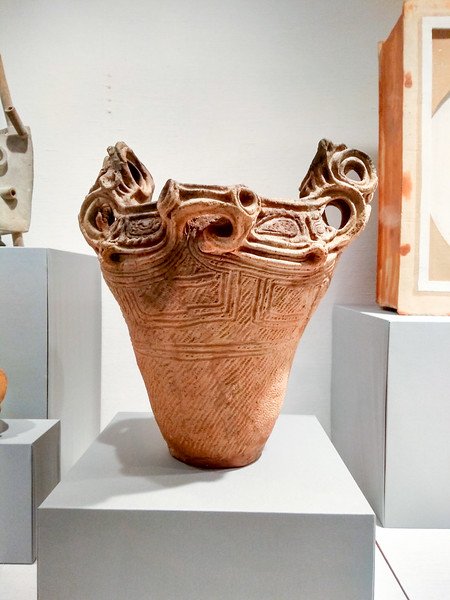
縄文 火焔土器 “Flame-rimmed” deep bowl (kaen doki)
Middle Jomon period (ca. 3500–2500 B.C.)
Earthenware with cord-marked and incised decoration

The other piece that the guide pointed out is a very modern piece, it is only 8 years old. This is the second time I have seen this very interesting and unique deer, the first time was on a highlights tour of the MET.
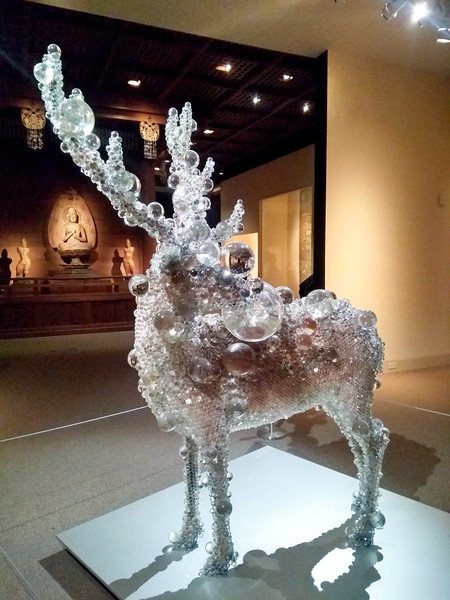
名和晃平作 PixCell-Deer#24
Kohei Nawa (Japanese, born 1975)
Heisei period (1989–2019)
2011
Mixed media; taxidermied deer with artificial crystal glass
The artist, Kohei Nawa covers found objects—including taxidermied animals he finds for sale online—with glass beads and other materials so that their original contours become mesmerizingly distorted, magnified, and reflective. 6
The first time I didn't know what to think. This time I was better prepared and was able to look at it with a new vision. It is startling and disturbing and so very interesting.
Thank you for joining me on this Tour of Japan at the MET!

Sources:
1 MET Gallery information
2 Willows and Bridge
3 Robe (kosode) with pine, ivy, chrysanthemums, and river
4 What Does Wabi-Sabi Mean?
5 Clog-Shaped Tea Bowl
6 PixCell-Deer#24
Art Talk Series Highlights
2018
Art Talk: Introduction
Art Talk: Emotion in Bronze
Art Talk: Moore Across America
Art Talk: Bronze
Art Talk: Moore in America
Art Talk: King and Queen
Art Talk: Art Tells Our Story
Art Talk: Highlight Tour of the MET
Art Talk: The Burghers of Calais
Art Talk: Auguste Rodin
Art Talk: Art in Paris in the 1870s
Art Talk: Guest Blogger, Frankie O'Neill
Art Talk: "Felt is a happy fabric."
Art Talk: Murals in Klamath Falls
Art Talk: Woman with a Parasol- Madame Monet and Her Son
Art Talk: Respect and Compassion
2019
Art Talk: Art Connects Us
Art Talk: My mother's crystal
Art Talk: Mother and Child
Art Talk: Tour of the Galleria dell' Accademia
Art Talk: Walking tour of Florence, Italy
Art Talk: Chihuly at the Oklahoma City Museum of Art
Art Talk: Vatican tour highlights
Art Talk: Ceilings in the Vatican
Art Talk: Chihuly at Kew Gardens
Art Talk: MET Highlight tour
This post was shared in the Curation Collective Discord community for curators, and upvoted and resteemed by the @c-squared community account after manual review.
@c-squared runs a community witness. Please consider using one of your witness votes on us here
Downvoting a post can decrease pending rewards and make it less visible. Common reasons:
Submit
Thanks!
Downvoting a post can decrease pending rewards and make it less visible. Common reasons:
Submit
I do like the MET, and this display looks really cool!
Downvoting a post can decrease pending rewards and make it less visible. Common reasons:
Submit
Hi Laura, Thanks for the comment. Yes, it is fun to do all different tours. I always learn so much!
Downvoting a post can decrease pending rewards and make it less visible. Common reasons:
Submit
Congratulations, Your Post Has Been Added To The Steemit Worldmap!
Author link: http://steemitworldmap.com?author=sjarvie5
Post link: http://steemitworldmap.com?post=art-talk-japan-at-the-met
Want to have your post on the map too?
Downvoting a post can decrease pending rewards and make it less visible. Common reasons:
Submit